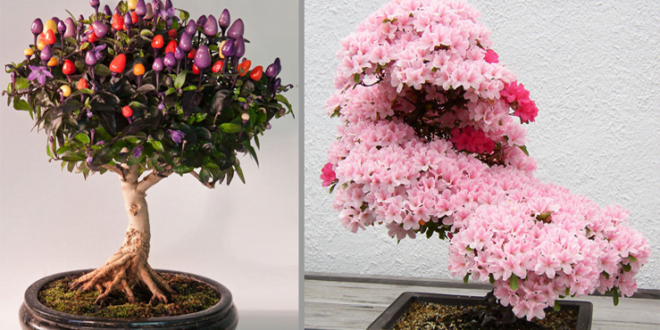Bonsai trees are awesome. Just ask Mr Miyagi. They look beautiful, they fit in your house, they encourage patience and dedication, they relieve stress, and they help to purify the air. What’s not to like?

An 800 year-old Bonsai tree at Shunkaen, by Kunio Kobayashi: A remarkable tree which is well known for its extremely high age; the tree is reported to be over 800 years old, one of the most expensive Bonsai trees! Its owner, master Kobayashi, is one of the most well known Bonsai artists in the world and has won the prestigious Prime Minister award in Japan 4 times. His nursery, ShunkaEn, is located in Tokyo and is open to visitors. For more information, read the Shunka-en Bonsai page, or check the Bonsai artist profile of Kunio Kobayashi.

Goshin “protector of the spirits”, by John Naka: Goshin (“protector of the spirit”) is a Bonsai created by John Y. Naka. It is a forest planting of eleven Foemina Junipers, the earliest of which Naka began training into Bonsai in 1948. Naka donated it to the National Bonsai Foundation in 1984, to be displayed at the United States National Arboretum; it has been there ever since. The tree is posted on our Bonsai homepage, but you can also read more about John Naka in his Bonsai artist profile.

Small Bonsai; a Shohin tree by Morten Albek: A gorgeous Rockspray Cotoneaster (Cotoneaster horisontalis). This is a picture taken in spring; the tree flowers in summer and has small red berries in wintertime. The tree is only 4″ (10cm) high and is planted on a miniature rock. The pot is made by John Pitt, a famous potter. The tree is about 20 years old on the picture and has been in training for about a decade. 
Flowering Bonsai, by Wolfgang Putz: This tree is an Azalea species of only 5″ (14cm) high. The picture is taken in late spring / early summer, the moment when Azalea trees bloom (shortly, but very vividly!). The tree is planted in a Japanese pot. We also have a Flowering Bonsai Top 10 article. Also, you can learn more about Wolfgang Putz in his Bonsai artist profile.

Brazilian rain tree, by Budi Sulistyo: This tree is grown from a small cutting and the result above is a picture taken 12 years later. A native of Central- and South America the Brazilian Rain tree is considered one of the tropical world’s most beautiful and also one of the most popular Bonsai subjects. Read the article on how this tree was cultivated and trained here!

Famous Bonsai; a Japanese maple (Acer palmatum), by Walter Pall: One of the most famous Bonsai trees that belongs to the collection of an European Bonsai artist (Walter Pall), this tree is incredibly fine and realistic. The maple is big (almost a meter high, which is the maximum to be called a Bonsai tree) and over a hundred years old. A masterpiece without doubt, styled by an inspiring artist! Check the history of this bonsaiempire.com website.

Bonsai master Kimura: Last but not least, Bonsai sensei Masahiko Kimura. His varied collection of Bonsai trees is world famous. Started at age 15, Kimura was an apprentice to master Hamano in Omiya Bonsai village. For more of his fascinating and sometimes unconventional work, visit Kimura’s Bonsai garden! Or read his Bonsai artist profile; Masahiko Kimura.

Wisteria vines can grow to epic proportions, spreading 100 feet or more under ideal growing conditions. The world’s largest known wisteria, located in Sierra Madre, Calif., was planted in 1894 and covers more than one acre. Planting wisteria is a long-term commitment. If you put a plant in the ground now, it may still be blooming and growing a century later if left undisturbed. One of the oldest wisteria vines, located in Japan’s Ashikaga Flower Park, dates back to 1870.

Wisteria: Wisteria brings to mind iconic purple flowers, but there are a variety of other colors including shades of white, pink, and blue. There are no yellow wisteria flowers, if you think you’ve seen one it was likely a golden chain tree (Laburnum). Wisterias are deciduous, which means they drop their leaves in the fall in response to cold temperatures. However, there is another vine commonly called evergreen wisteria (Millettia reticulata), that sometimes causes confusion.

Chinese styled trees; a Penjing landscape by Yee-sun Wu: This wonderful Chinese landscape belongs to the Man Lung collection in Hong Kong. The trees are Chinese Bird Plums (Sageretia Theezans) and together make up a very realistic scenery. In the collection Ficus Bonsai are also popular. In this landscape, the trees, rock and miniature figurines are placed on a shallow rectangular pot (made of marble), which in turn is displayed on an antique table.

Azaleas experience an explosion of flowers during the spring. It is essential to know how the flowering of this rhododendron works in order to favour it and enhance its possibilities. In this post we will explain you how to boost flowering of your azalea bonsai in two easy steps, so you can enjoy its flowers for longer and you can make the most of the blooming season. Azaleas are flowering shrubs in the Ericaceae family, they are also rhododendrons and members of the genus Rhododendron. Azaleas can be either deciduous or evergreen. In Japan it is a very popular plant, often used for the creation of bonsai. They are commonly known as the ‘royalty of the garden’ because of their brightly coloured flowers and its intense green foliage.

Bougainvillea Bonsai: The Bougainvillea tree itself makes a great bonsai tree in South Africa. They are known for their huge flowers that come in various sizes. When you see a Bougainvillea bonsai tree you will know it. They are consider a sub-tropical plant/tree specie. Originally, the Bougainvillea was found in South America.

Maple Bonsai ((Acer Palmatum)) by Michael: The Japanese maple has a scientific name of Acer palmatum. It is aptly named, as the five-lobed leaves of this plant look just like a hand – and “palma ” is the Latin word for the palm of your hand. The Japanese Maple is well-known for its lovely appearance. There are multiple cultivars available, most of which produce unique leaf colors and shapes and grow to various sizes. These plants are popular not only as bonsai specimens, but also as ornamental shrubs. Japanese Red Maple bonsai can be grown from seeds or cuttings. Ideally, it should be propagated (regardless of the method) in early summer. You can use air-layering to propagate a Japanese Red Maple or you can purchase it as a starter plant from a nursery. If you are going to plant from seeds, you will want to place the seeds in the refrigerator for 100 days. This will allow stratification to occur, which breaks down the tough seed coating and prepares the seeds for germination. Then, let the seeds soak for at least 24 hours before planting. You can plant in a heat-proof container.

Apple Tree: Great bonsai gardeners go an extra mile of growing their trees instead of buying them. If you need to grow apple bonsai trees, you can use apple seeds or apple cutting. Since apple trees are not self-pollinating, you need at least two apple plants of a different type for your bonsai to bear fruits. Let’s look at both ways to learn how to turn an apple tree into a perfect bonsai tree.

Adenium Bonsai by Siam adenium: Adenium arabicum can also be grown as a bonsai, with beautiful red flowers. Sowing takes place in plastic pots. Either commercially available mineral-based cat litter, pearlite or pumice gravel is used as the substrate. Spread the seeds evenly on the substrate. Cover larger seeds thinly with substrate, fine seeds can remain on the surface. Then place the plastic pot in a zip-lock bag – pot size of 6 cm, a zip-lock bag size 120 x 170 mm is recommended. Pour enough tap water with a few drops of universal fertilizer into the zip-lock bag so that a few mm of water remain visible after the substrate has absorbed what it needs needs. Location: on the window sill or in a mini greenhouse in partial shade, during the day the temperatures should be around 23 – 28 C, at night a little lower at 20 – 22 C.

This 390 Year-old Bonsai Tree Survived Hiroshima: Now living in Washington, D.C., this bonsai tree outlasted the atomic blast. For 25 years, one of those trees sat near the entrance of the National Bonsai and Penjing Museum at the United States National Arboretum in Washington D.C., its impressive life story largely unknown. When Yamaki donated the now 390-year-old white pine bonsai tree to be part of a 53 bonsais gifted by the Nippon Bosnai Association to the United States for its bicentennial celebration in 1976, all that was really known was the tree’s donor. Its secret would remain hidden until 2001, when two of Yamaki’s grandsons made an unannounced visit to the Arboretum in search of the tree they had heard about their entire lives.

Sakura: Bonsai sakura can reach large sizes in natural conditions. With proper care, it will be placed in a small pot, while remaining an exact copy of the Japanese cherry. Sakura is a recognized symbol of East Asia that accompanies the national holiday. It is possible to grow a reduced propagation of such a tree at home, but this process is long and laborious. Sakura bonsai is an ornamental tree that can easily take root in a home. It is resistant to increased gas pollution in the room, but requires good light and daily watering.

Bonsai Chile Tree: Making a bonsai tree yourself is a tedious business. You should plan about 5 – 10 years for a deciduous tree. In addition, you can correct errors during pruning only slowly. Isn’t it obvious to start with fast growing chillies as a beginner? he advantages of chili plants as bonsai are immediately noticeable when you look sharply. Chillies grow fast and are easy to obtain. You can grow Capsicum plants from chili seeds yourself with little effort. Chillies also form a woody trunk. All this allows you to quickly learn the art of bonsai. With all the advantages, the plants, flowers and fruits also look decorative.
 Viral Hatch US/UK No.1 News Portal
Viral Hatch US/UK No.1 News Portal







